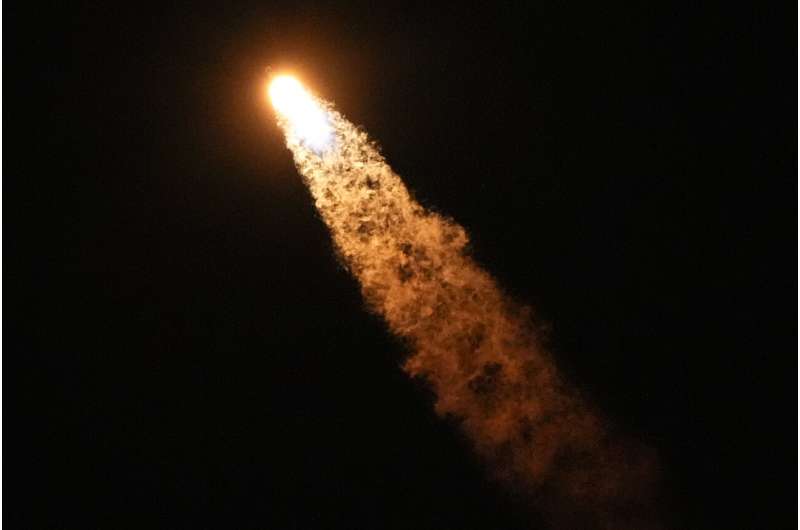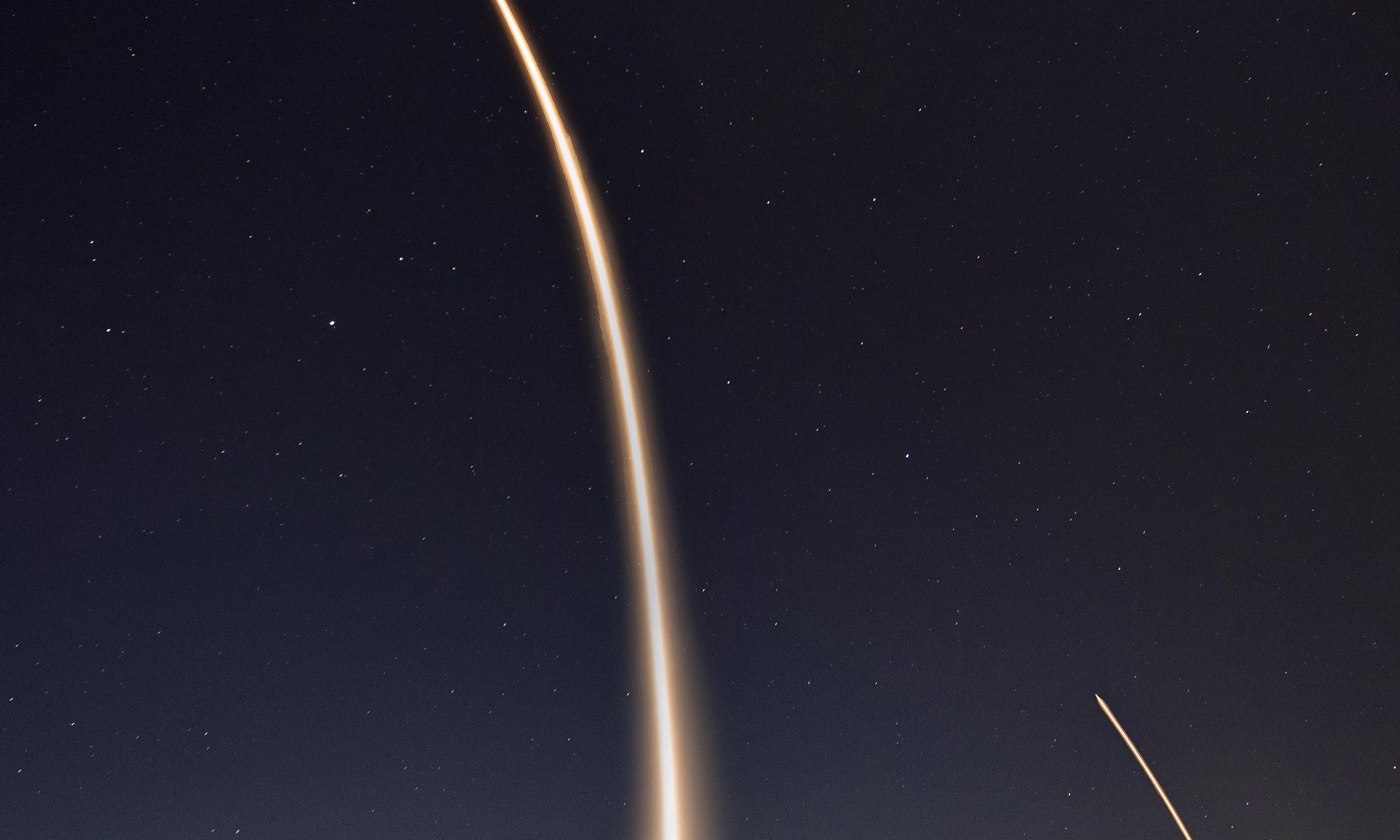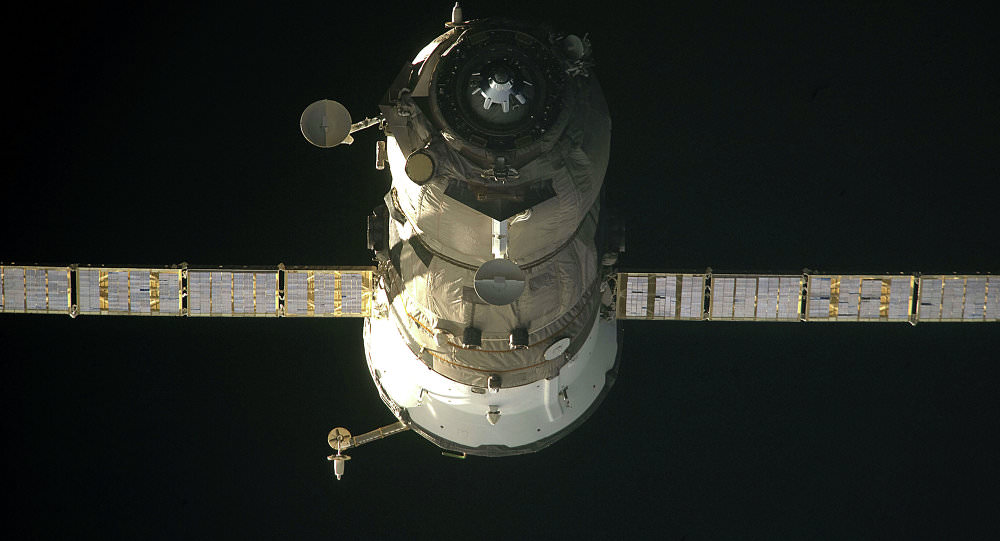Space travel seems to be a fairly regular occurrence now with crews hopping up and down to the International Space Station. This week, another crew arrived on board a SpaceX Dragon capsule known as Endeavour. On board were NASA astronauts Matthew Dominick, Michael Barratt and Jeanette Epps along with cosmonaut Alexander Grebenkin. The ISS already had seven people on board so this brought the total crew to eleven. The launch almost got cancelled due to a crack in the hatch seal.
Continue reading “Crew-8 Arrives at the ISS, Despite a Crack in the Capsule”Two Rockets at Cape Canaveral

An interesting photo-op took place at Launch Complex 39 at NASA’s Kennedy Space Center in Florida last week. On April 6th, two different rockets were photographed occupying neighboring launch pads – LC 39A and 39B. The former was occupied by the Falcon 9 rocket and Dragon capsule (visible in the foreground) that launched the first all-private mission to the International Space Station (ISS) on April 8th – the Axiom Mission 1 (Ax-1).
The latter was occupied by the NASA Space Launch System (SLS) rocket and Orion Spacecraft that will be used to conduct the inaugural launch of the Artemis Program (Artemis I) this summer (seen in the background). This is the first time two different types of rockets and spacecraft occupied LC 39’s sister pads simultaneously. This will become the norm in the future as the KSC continues to grow and becomes a multi-user spaceport that launches government and commercial rockets.
Further Reading: NASA
SpaceX Launches its Last Dragon 1 Mission to the ISS
On Friday, March 6th, as part of the company’s 20th Commercial Resupply Services (CRS-20) mission, SpaceX launched a Dragon 1 capsule destined for the International Space Station (ISS). The mission involved the transport of supplies, as well as materials related to the more than 250 science investigations taking place aboard the ISS. More than that, it represented a milestone for the aerospace manufacturer.
Continue reading “SpaceX Launches its Last Dragon 1 Mission to the ISS”Three Words: SpaceX… Mars… 2018
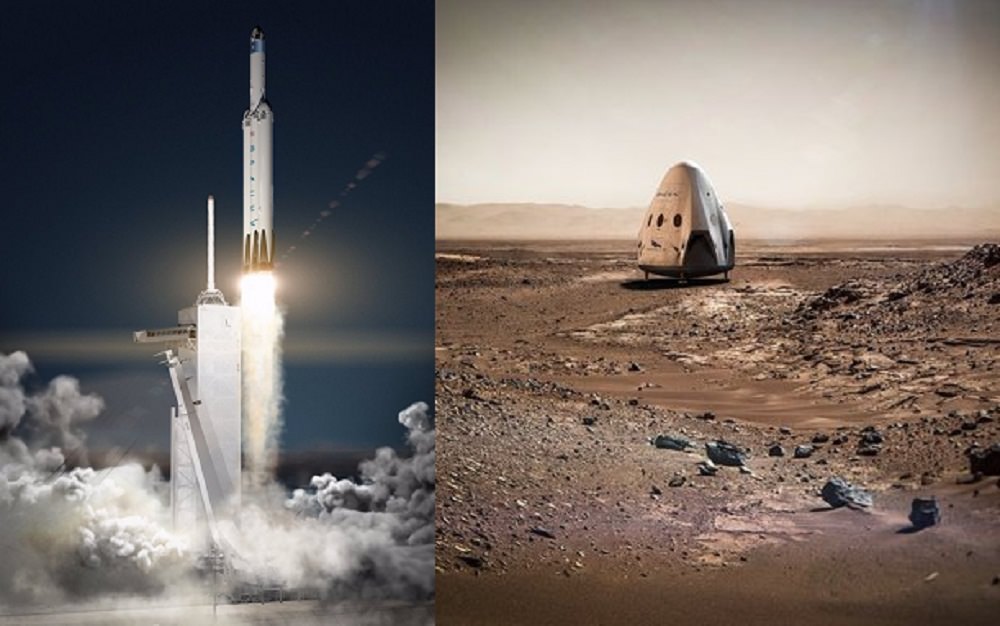
Fans of Elon Musk and commercial space exploration are buzzing over the news! Back in 2002, when Musk first established the private aerospace company SpaceX, he did so with the intent of creating the technologies needed to reduce the cost of space transportation and enable crewed missions to Mars. And for the past few years, industry and the general public alike have been waiting on him to say when missions to Mars might truly begin.
Earlier this morning, Elon Musk did just that, when he tweeted from his company account that SpaceX plans to send a Dragon capsule to Mars by 2018. Despite talking about his eventual plans to mount crewed missions to Mars in the coming decades, and to even build a colony there, this is the first time that a specific date has been attached to any plans.
What was also indicated in the announcement was that the missions would be built around the “Red Dragon” mission architecture. As a modified, unmanned version of the Dragon capsule, this craft was conceived back in 2013 and 2015 as part of the NASA Discovery Program – specifically for Mission 13, a series of concepts which are scheduled to launch sometime in 2022.
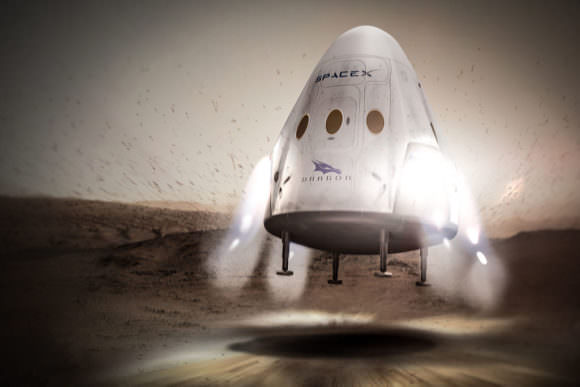
Though the idea was never submitted to NASA, SpaceX has kept them on hand as part of a proposed low-cost Mars lander mission that would deploy a sample-return rover to the Martian surface. The mission will be deployed using a Falcon Heavy rocket, based on the mission profile and the illustrations that accompanied the announcement.
This mission would not only demonstrate SpaceX’s ability to procure samples from the Martian environment and bring them back to Earth – something that only federal space agencies like NASA have been able to do so far – but also test techniques and equipment that human crews will be using to enter the Martian atmosphere.
And if all goes well, we can expect that Musk will push forward with his plans for both crewed missions, and the development of all the necessary architecture to being work on his Mars Colonial Transporter, which he hopes to use to begin ferrying people to Mars to build his planned colony.
Stay tuned for more in-depth analysis of this announcement from our resident expert, Ken Kremer!
SpaceX Sets Ambitious Falcon 9 ‘Return to Flight’ Agenda with Dual December Blastoffs
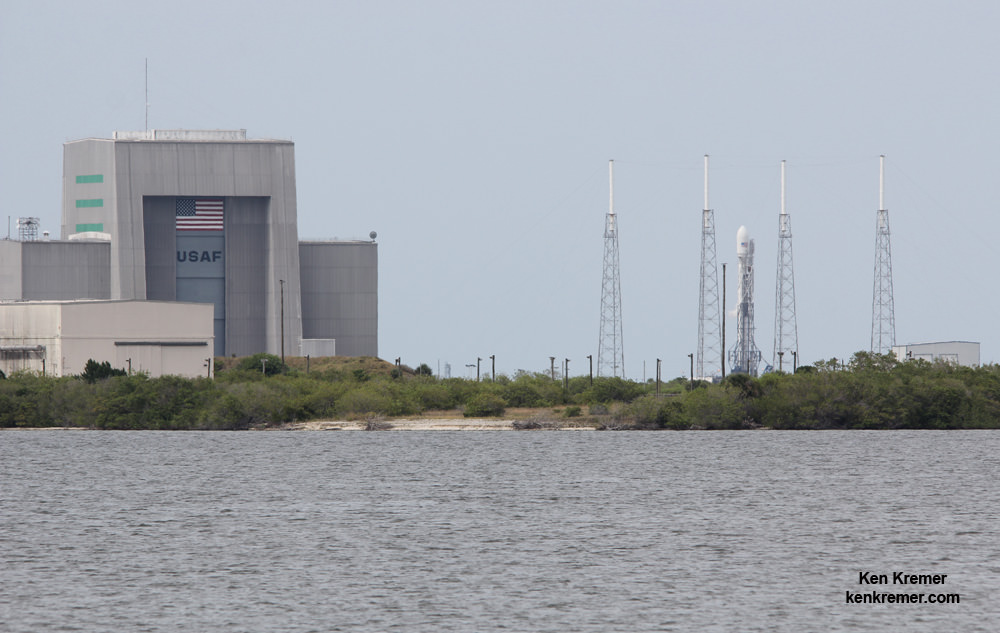

SpaceX plans an ambitious ‘Return to Flight’ agenda with their Falcon 9 rocket comprising dual launches this coming December, nearly six months after their failed launch in June 2015 that culminated in the total mid-air loss of the rocket and NASA cargo bound for the crew aboard the International Space Station (ISS).
The double barreled salvo of Falcon 9 blastoffs both involve launches of commercial communications satellites – first for Orbcomm followed by SES – and are specifically devised to allow a gradually ramp up in complexity, as SpaceX introduces fixes for the launch failure and multiple improvements to the boosters overall design. Continue reading “SpaceX Sets Ambitious Falcon 9 ‘Return to Flight’ Agenda with Dual December Blastoffs”
SpaceX set for Station Resupply Blastoff with Crew Docking Adapter and Bold Landing Attempt on June 28 – Watch Live
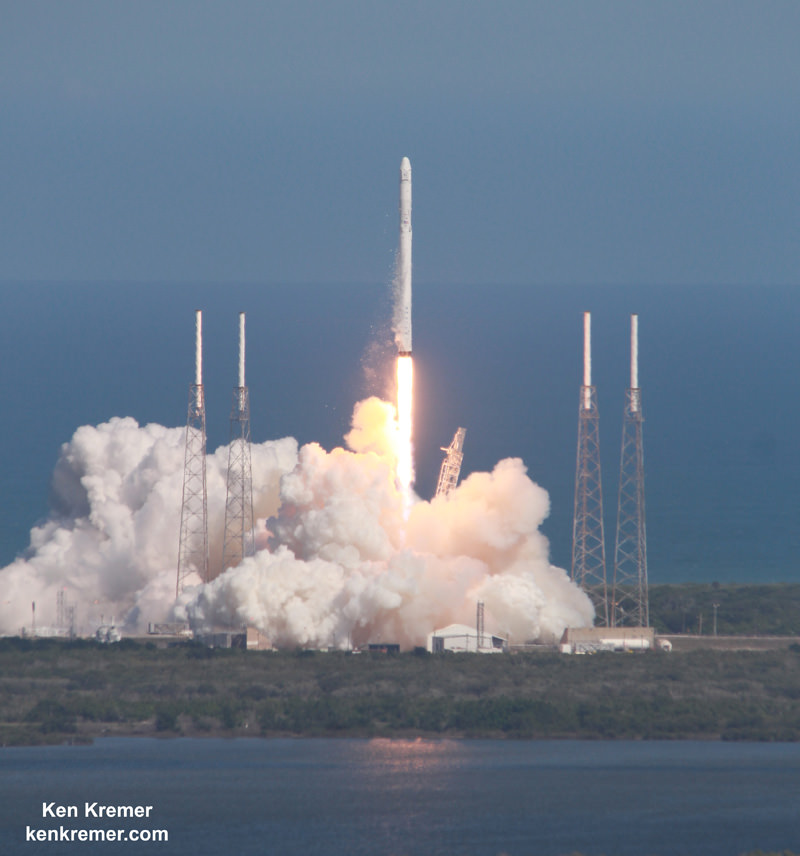
SpaceX Falcon 9 and Dragon are due to blastoff on June 28, 2015 from Space Launch Complex 40 at Cape Canaveral Air Force Station in Florida at 10:21 a.m. EDT on the CRS-7 mission to the International Space Station. Photo of last SpaceX launch to ISS in April 2015. Credit: Ken Kremer/kenkremer.com
Story updated[/caption]
KENNEDY SPACE CENTER, FL – With launch less than a day away for SpaceX’s seventh commercial resupply mission carrying a two ton payload of critical science and cargo for the future buildup of human spaceflight to the International Space Station (ISS) on Sunday, June 28, “everything is looking great” and all systems are GO, Hans Koenigsmann, SpaceX VP of mission assurance announced at a media briefing for reporters at the Kennedy Space Center.
The weather outlook along the Florida Space Coast is fantastic as U.S. Air Force 45th Weather Squadron forecasters are predicting a 90 percent chance of favorable conditions for lift off of the SpaceX Falcon 9 rocket and Dragon spacecraft, slated for 10:21 a.m. EDT, Sunday, June 28, from Space Launch Complex 40 at Cape Canaveral Air Force Station in Florida.
The Falcon 9 first stage is outfitted with four landing legs and grid fins to enable the landing attempt, which is a secondary objective of SpaceX. Cargo delivery to the station is the overriding primary objective and the entire reason for the CRS-7 mission.
If you are free this weekend and all continues to go well, this could well be your chance to be an eyewitness to a magnificent space launch in sunny Florida – and see a flight that signifies significant progress towards restoring America’s ability to once again launch our astronauts on American rockets from American soil.
NASA Television plans live launch coverage starting at 9 a.m EDT on June 28:
You can watch the launch live on NASA TV here: http://www.nasa.gov/nasatv
SpaceX also plans live launch coverage: www.spacex.com/webcast

The launch window is instantaneous, meaning that the rocket must liftoff at the precisely appointed time. Any delays like on Monday due to weather or technical factors will force a scrub.
The mission is critical for NASA in more ways than one, in addition to the science cargo, the SpaceX Dragon spaceship is loaded with the first of two International Docking Adapters (IDA’s), pictured below, that will be connected to the space station to provide a place for Commercial Crew spacecraft carrying astronauts to dock to the orbiting laboratory as soon as 2017.
The approximately 30 inch thick and ring shaped IDA is loaded in the unpressurized truck section at the rear of the Dragon.
The pressurized section of the Dragon is packed with over 4,000 pounds of research experiments, spare parts, gear, high pressure supply gases, food, water and clothing for the astronaut and cosmonaut crews comprising Expeditions 44 and 45.
These include critical materials for the science and research investigations for the first ever one-year crew to serve aboard the ISS – comprising NASA astronaut Scott Kelly and Russian cosmonaut Mikhail Kornienko.
The science payloads will offer new insight to combustion in microgravity, perform the first space-based observations of meteors entering Earth’s atmosphere, continue solving potential crew health risks and make new strides toward being able to grow food in space, says NASA.
Some three dozen student science experiments are also flying aboard. The cargo also includes the METEOR camera.
Both IDA’s were built by Boeing. They will enable docking by the new space taxis being built by Boeing and Space X – the CST-100 and crew Dragon respectively, to carry our crews to the ISS and end our sole source reliance on the Russian Soyuz capsule.
IDA 1 will be attached to the forward port on the Harmony node, where the space shuttles used to dock.
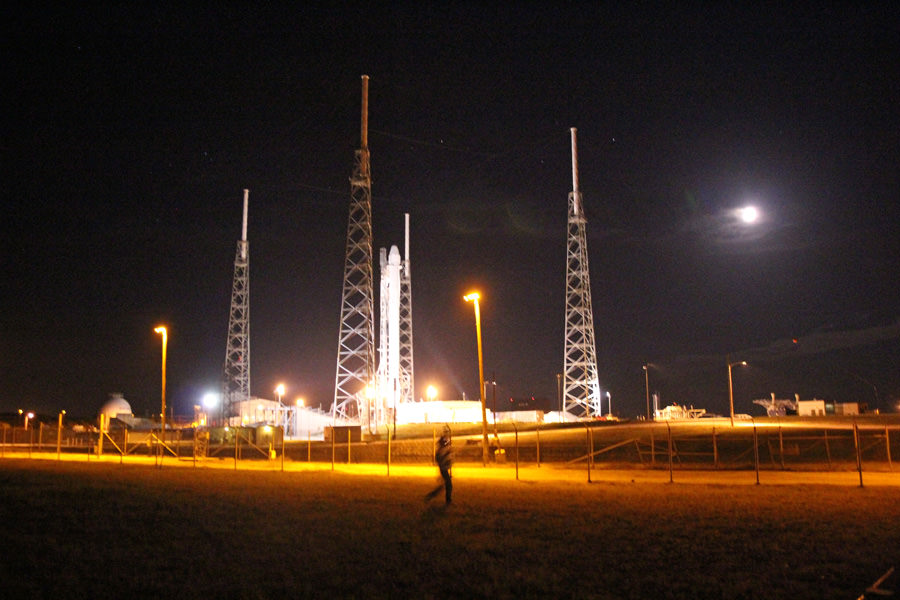
If Dragon launches on Sunday as planned, it will reach the space station after a two day pursuit on Tuesday, June 30.
NASA’s Scott Kelly of NASA will use the station’s Canadarm2 robotic arm to reach out and capture Dragon at about 7 a.m. He will be assisted by Station commander Gennady Padalka of the Russian Federal Space Agency (Roscosmos) as they operate the 57 foot long arm from the station’s cupola.
NASA TV coverage of rendezvous and grapple of Dragon will begin at 5:30 a.m. on Tuesday. Coverage of Dragon’s installation to the Earth-facing port of the Harmony module will begin at 8:30 a.m.
The ship will remain berthed at the ISS for about five weeks.
Watch for Ken’s continuing onsite coverage of the CRS-7 launch from the Kennedy Space Center and Cape Canaveral Air Force Station.
Stay tuned here for Ken’s continuing Earth and planetary science and human spaceflight news.
………….
Learn more about SpaceX, Boeing, Space Taxis, Europa, Rosetta, Mars rovers, Orion, SLS, Antares, NASA missions and more at Ken’s upcoming outreach events:
Jun 27-28: “SpaceX launch, Orion, Commercial crew, Curiosity explores Mars, Antares and more,” Kennedy Space Center Quality Inn, Titusville, FL, evenings
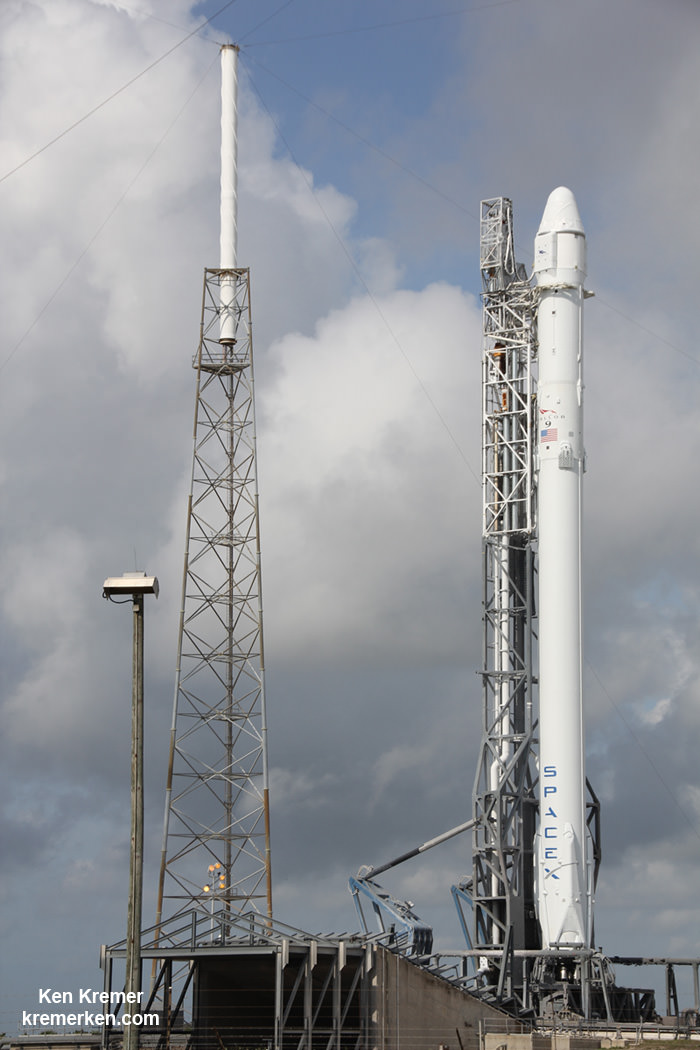
Russia’s Out of Control Progress Freighter Doomed to Fiery Finale Friday
Russia’s out-of-control Progress 59 cargo freighter is doomed to a fiery finale overnight Friday, May 8, according to Roscosmos, the Russian Space Agency.
The errant spaceship is expected to fall back to Earth and reenter the atmosphere early in the morning Moscow time following the latest orbital analysis by Roscosmos.
“The time window for the failed Progress spacecraft reentry in the Earth’s atmosphere was changed to a span between 01.13 a.m. and 04.51 a.m. Moscow time on May 8, according to Russia’s space agency Roscosmos,” according to the latest update today, May 7, from the Russian Sputnik news outlet.
According to a Roscosmos source, the unmanned Progress 59, also known as M-27M , would most likely make the atmospheric reentry over the Indian Ocean.
Roscosmos said in a statement that Progress 59 “will cease to exist” on Friday.
Most of the debris is expected to burn up. But any remaining fragments are likely to hit north of Madagascar.
Russian mission controllers lost control of the Progress 59 spacecraft ship – bound for the International Space Station (ISS) on a routine resupply mission – shortly after its otherwise successful launch on April 28 from the Baikonur space center in Kazakhstan atop a Soyuz-2.1A carrier rocket.
Soon after detaching from the rockets third stage, it began to spin out of control at about 1.8 times per second, as seen in a video transmitted from the doomed ship.
After control could not be reestablished, all hope of docking with the ISS was abandoned by Roscosmos.
Here’s a short video taken by the spinning Progress with NASA commentary:
The 7 ton vehicle was loaded with 2.5 tons of supplies for the ISS and the six person Expedition 43 crew. Items included personal mail for the crew, scientific equipment, as well as replaceable parts for the station’s life support systems and a stockpile of water and oxygen, according to Russia Today.
The Progress spacecraft is also loaded with a significant amount of fuel as it orbits Earth at an inclination of 51.6 degrees to the equator. This carries it over most of the populated world between 51.6 degrees north and south latitudes. But most of the area is over unpopulated oceans, making the chances of danger from falling debris very small.
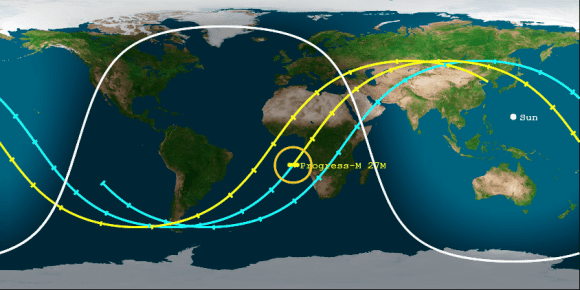
To date the Progress vehicle have been highly reliable. The last failure occurred in 2011, shortly after the retirement of NASA’s Space Shuttle orbiters in July 2011.
Roscosmos has established an investigation board to determine the cause of the Progress failure and any commonalities it might have with manned launches of the Soyuz rocket and capsule.
“The conclusions are to be made by May 13, 2015,” according to a Roscosmos statement.
The potential exists for a delay in the next planned manned Soyuz launch with a three person international crew later on May 26 from the Baikonur Cosmodrome in Kazakhstan.
The ISS crew is in no danger and has sufficient supplies to last until at least September.
Besides the Russian Progress cargo ship, the ISS is resupplied by the commercial US SpaceX Dragon and Orbital Sciences Cygnus vessels and the Japanese HTV. ESA’s ATV has been retired after 5 flights.
The next Falcon 9 launch carrying the CRS-7 Dragon cargo ship on a resupply mission for NASA to the ISS is slated for mid-June. The most recent Dragon was launched on the CRS-6 mission on April 14, 2015.
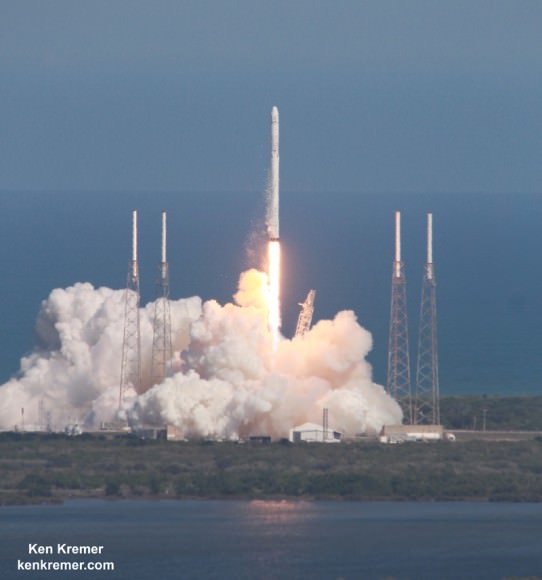
The last Orbital Sciences launch of an Antares rocket with the Orb-3 Cygnus resupply ship ended in a catastrophic explosion just seconds after liftoff on October 28, 2014.
The ISS lifeline hangs by a delicate thread.
Stay tuned here for Ken’s continuing Earth and planetary science and human spaceflight news.
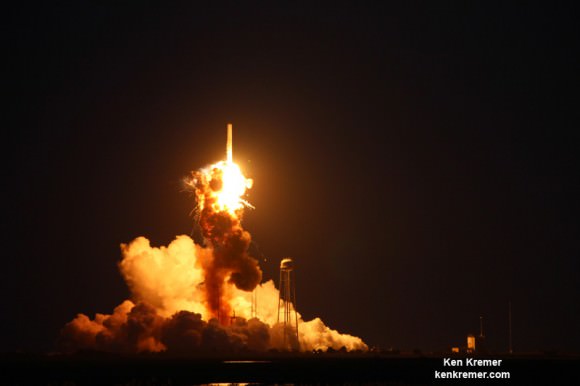
SpaceX Completes Successful Crew Dragon Test of Astronaut Life Saving Escape System
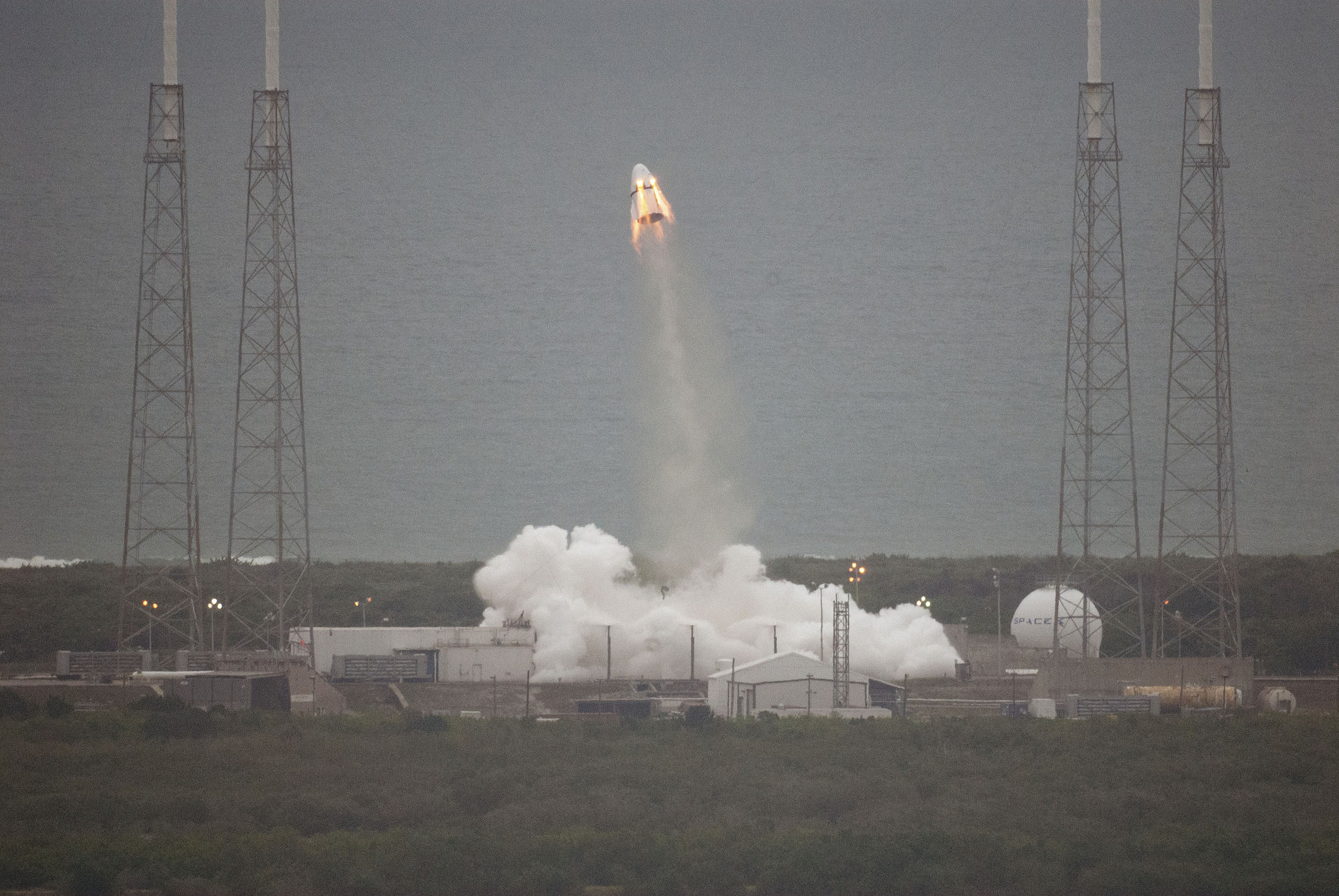
Soaring on the power of an octet of SuperDrago engines, SpaceX successfully completed a critical rapid fire life-saving test of their Dragon crew capsules pad abort emergency escape system that would ignite in a split second to save the astronauts lives in the unlikely event of a failure of the Falcon 9 booster rocket at the Cape Canaveral launch pad.
The uncrewed SpaceX Crew Dragon roared swiftly skywards upon ignition of the test vehicle’s integrated SuperDraco engines at 9 a.m EDT this morning, Wednesday, May 6, for the mile high test conducted from the SpaceX Falcon 9 launch pad from a specially built platform at Space Launch Complex 40 (SLC-40) at Cape Canaveral Air Force Station, Florida.
A human-sized crash test dummy was seated inside for the test exercise which ended safely with a parachute assisted Atlantic Ocean splashdown after less than two minutes. There were no astronauts aboard.
The SuperDraco engines fired for approximately six seconds and accelerated the crew Dragon “from 0 to 100 mph in 1.2 seconds. It reached a top speed of about 345 mph,” said SpaceX CEO Elon Musk in a post test briefing.
“This bodes quite well for the future of the program. I don’t want to jinx it, but this is really quite a good indication for the future of Dragon.” said Elon Musk.
“We hope to launch the first crews to the ISS within about two years, plus or minus six months.”
The side mounted escape engines mark a revolutionary change from the traditional top mounted launch escape system used previously in the Mercury, Apollo, Soyuz and Orion human spaceflight capsules. The space shuttle had no escape system beyond ejections seats used on the first four flights.
Dragon was mounted atop the finned trunk section for the test. The entire Dragon/trunk assembly was about 20 feet (5 meters) tall.
The test is a critical milestone towards the timely development of the human rated Dragon that NASA is counting on to restore the US capability to launch astronauts from US soil abroad US rockets to the International Space Station (ISS) as early as 2017.
“This is a critical step toward ensuring crew safety for government and commercial endeavors in low-Earth orbit,” said Kathy Lueders, manager of NASA’s Commercial Crew Program.
“Congratulations to SpaceX on what appears to have been a successful test on the company’s road toward achieving NASA certification of the Crew Dragon spacecraft for missions to and from the International Space Station.”
Here is a video of the Pad Abort Test:
Video caption: Powered by its SuperDraco engines, the uncrewed SpaceX Crew Dragon flies through its paces in the Pad Abort Test from Cape Canaveral Air Force Station in Florida. Credit: NASA
After all the monomethylhydrazine and nitrogen tetroxide hypergolic propellants were consumed, Dragon soared as planned to an altitude of about 1500 meters (.93 mi) above the launch pad. At about T+21 seconds the trunk was jettisoned and the spacecraft began a slow rotation with its heat shield pointed toward the ground again as it arced out eastwards over the ocean.
The drogue chutes and trio of red and white main parachutes deployed as planned for a picturesque Dragon splashdown in the Atlantic Ocean about a mile offshore of its Cape Canaveral launch pad. The capsule was retrieved from the ocean by waiting recovery boats.
Today’s pad abort demonstration tested the ability of the set of eight SuperDraco engines integrated directly into the side walls of the crew Dragon to ignite simultaneously and pull the vehicle away from the launch pad in a split second – in a simulated emergency to save the astronauts lives in the event of a real emergency.
Therefore the Pad Abort Test did not include an actual Falcon 9 booster since it was focused on a checkout of the capsule’s escape capability.
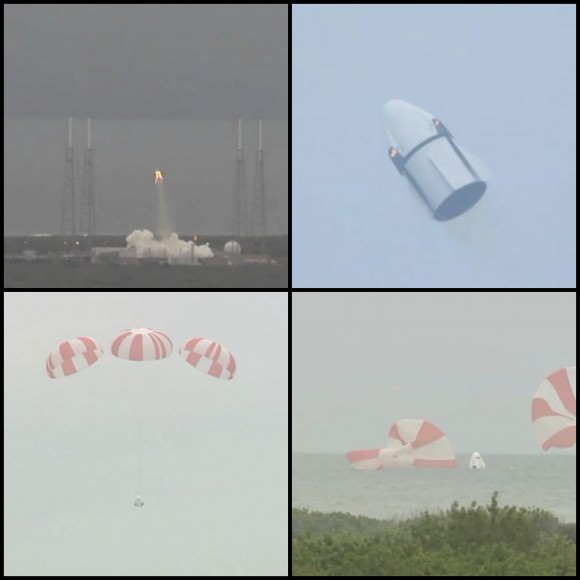
The SuperDraco engines are located in four jet packs built into the capsule around the base. Each engine produces about 15,000 pounds of thrust pounds of axial thrust, for a combined total thrust of about 120,000 pounds in under one second, to propel the astronauts safely away.
The entire test lasted less than two minutes.
The test was webcast live on NASA TV: http://www.nasa.gov/nasatv
The crew Dragon is outfitted with 270 sensors to measure a wide range of vehicle, engine, acceleration and abort test parameters.
The pad abort test was accomplished under SpaceX’s Commercial Crew Integrated Capability (CCiCap) agreement with NASA, that will eventually lead to certification of the Dragon for crewed missions to low Earth orbit and the ISS.
A second Dragon flight test follows later in the year, perhaps in the summer. It will launch from a SpaceX pad at Vandenberg Air Force Base in California and involves simulating an in flight emergency abort scenario during ascent at high altitude at maximum aerodynamic pressure (Max-Q) at about T plus 1 minute, to save astronauts lives.
The pusher abort thrusters would propel the capsule and crew safely away from a failing Falcon 9 booster for a parachute assisted splashdown into the ocean.
“This is what SpaceX was basically founded for, human spaceflight,” said Hans Koenigsmann, vice president of Mission Assurance with SpaceX, at a prelaunch briefing.
“The pad abort is going to show that we’ve developed a revolutionary system for the safety of the astronauts, and this test is going to show how it works. It’s our first big test on the Crew Dragon.”
Stay tuned here for Ken’s continuing Earth and planetary science and human spaceflight news.
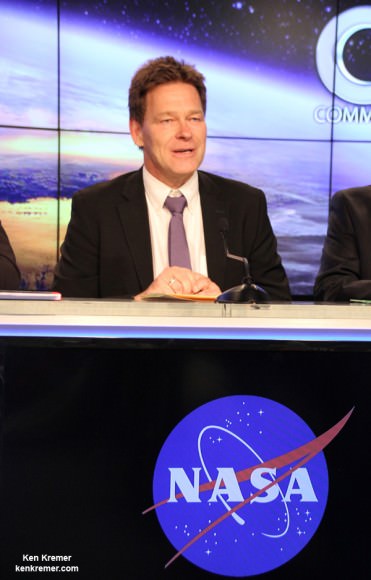
Spectacular 5th SpaceX Launch in 2015 Sets Record Pace, Clears Path for Critical Flights Ahead
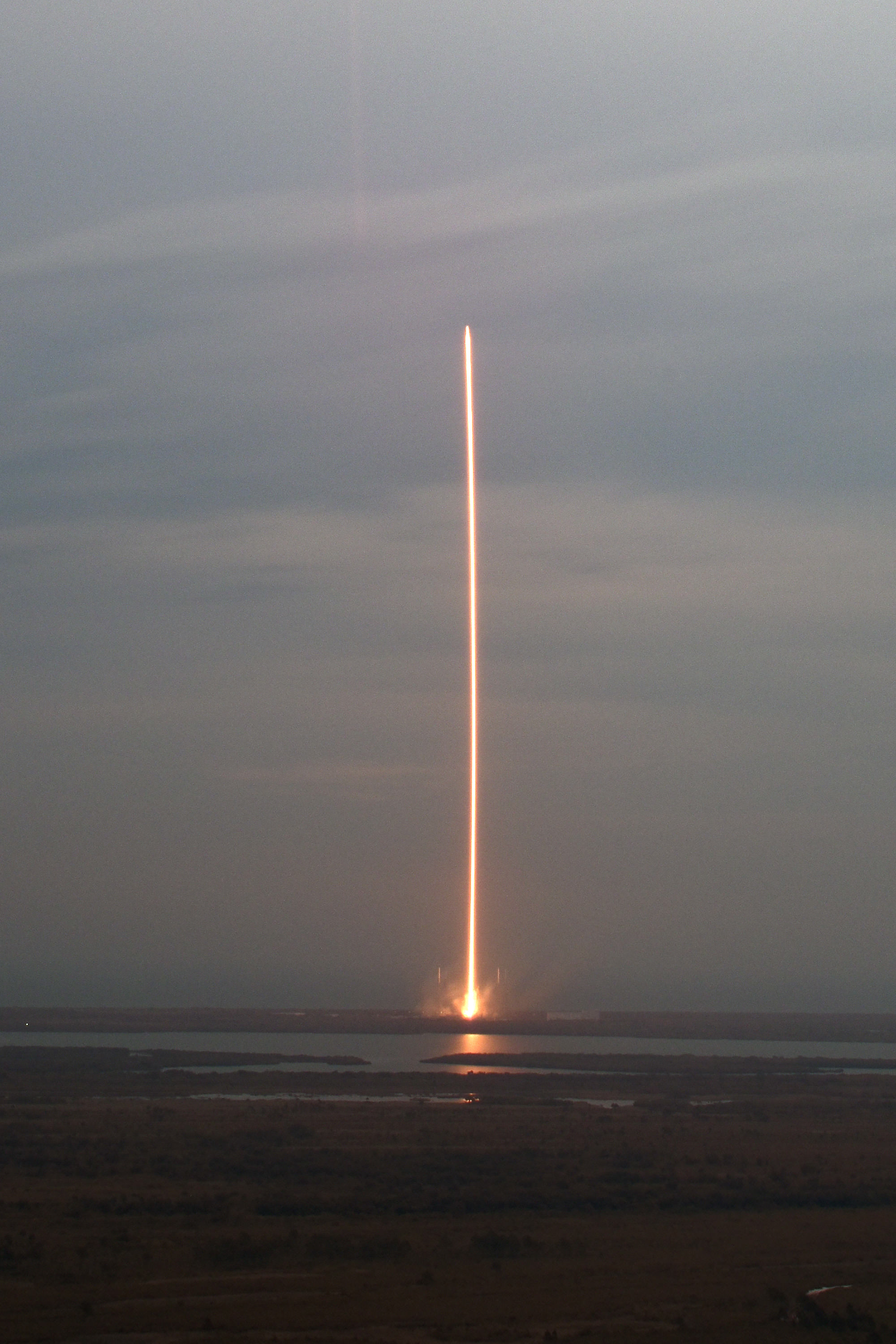
SpaceX set a new internal record pace for time between blastoffs of their workhorse Falcon 9 rocket with Monday’s spectacular dusky liftoff of Turkmenistan’s first satellite into heavily overcast skies that has cleared the path ahead for a busy manifest of critical flights starting with a critical pad abort test for NASA just a week from today.
After a 49 minute delay due to grim weather conditions, weather officials finally found a “window in the clouds” that permitted the Falcon 9 to launch on Monday, April 27, 2015 at 7:03pm EDT (2303 GMT).
The launch took place just 13 days after successfully launching the SpaceX Dragon CRS-6 resupply freighter to the International Space Station (ISS) for NASA on April 14.
Overall this launch marked Falcon 9’s fifth launch in four months and second in 13 days, besting SpaceX’s previous turnaround record by one day.
But it was touch and go all afternoon, when two weather rules related to cloudy conditions violated the launch commit criteria and forced a no go from the originally planned 6:14 liftoff time.
The situation was not at all promising when the weather officer announced “NO GO” during the prelaunch poll that resulted in a recycle to the T minus 20 minute mark with seemingly little prospect of a launch. Then all of a sudden, conditions improved and the count was resumed and “wet off without a hitch” said SpaceX.
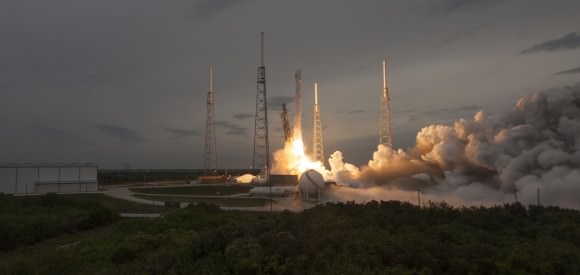
The 224 foot tall SpaceX Falcon 9 launched on a commercial mission for Thales Alenia Space carrying the first ever communications satellite for the nation of Turkmenistan.
The TurkmenÄlem52E/MonacoSat satellite was built by Thales Alenia Space.
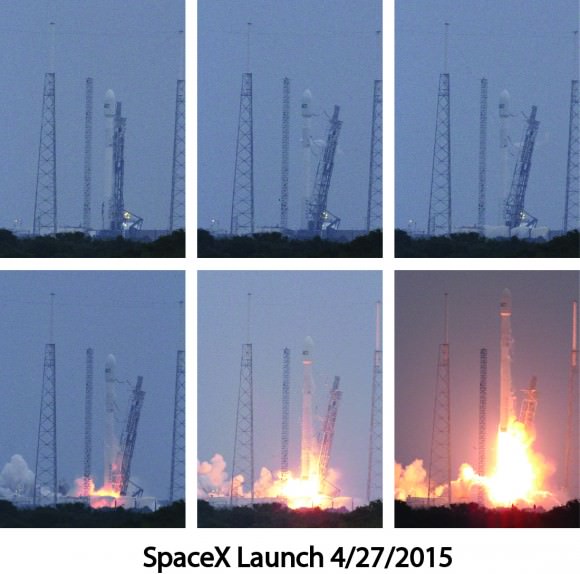
The 14 story Falcon 9 first stage is powered by 9 Merlin 1D engines that generate about 1.3 million pounds of thrust.
The Falcon 9’s first and second stages separated three minutes after launch. The second stage fired for six minutes for its first burn to reach the initial parking orbit. It then reignited twenty-six minutes into flight, to completed a one-minute burn.
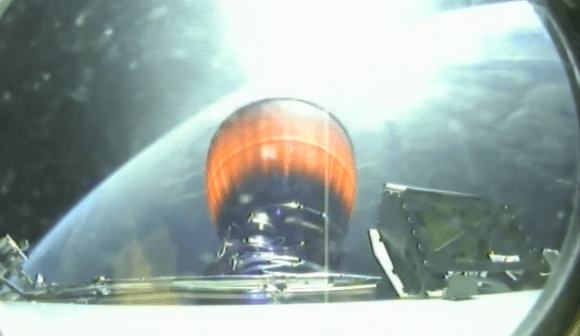
The launch delivered the 10,375-pound (4500 kg) TurkmenÄlem52E/MonacoSat satellite to a geosynchronous transfer orbit. The satellite was deployed as planned approximately 32 minutes after liftoff.
Launches are never easy, as exemplified by a post launch tweet from SpaceX CEO Elon Musk after the satellite was deployed from the second stage.
‘Rocket launch good, satellite in geo transfer orbit. Still so damn intense. Looking fwd to it feeling normal one day,” tweeted Musk.
Despite the launch of Turkmenistan’s first communications satellite, the country is conducting a war on satellite dishes to receive the signals according to Human Rights Watch.
“Authorities in Turkmenistan are forcing residents to dismantle privately owned satellite dishes,” Human Rights Watch said in a statement on April 24. “A move that unjustifiably interferes with the right to receive and impart information and ideas, this serves to further isolate people in Turkmenistan, one of the most closed and repressive countries in the world, from independent sources of news and information.”
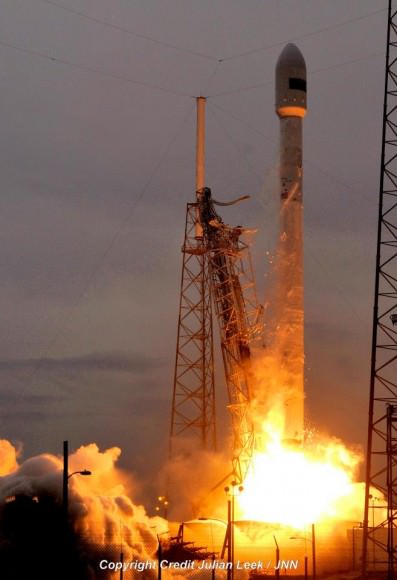
Just 1 week from today on May 5, SpaceX plans a pad abort test for NASA that is critical for the timely development of the human rated Dragon that NASA is counting on to restore the US capability to launch astronauts from US soil to the space station.
The next Falcon 9 launch is slated for mid-June carrying the CRS-7 Dragon cargo ship on a NASA mission to the ISS.
There was no attempt to soft land the Falcon 9 first stage during the April 27 launch. Due to the heavy weight of the TurkmenÄlem52E/MonacoSat satellite there was not enough residual fuel for a landing attempt on SpaceX’s ocean going barge.
The next landing attempt is set for the CRS-7 mission.
Stay tuned here for Ken’s continuing Earth and planetary science and human spaceflight news.
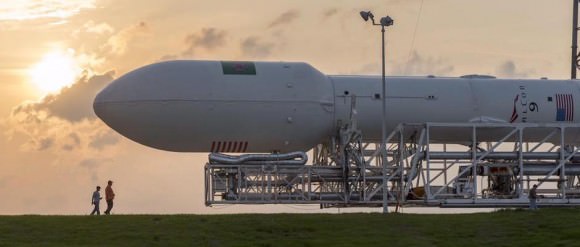
SpaceX Picks Up Launch Pace; Sets April 27 Commercial Launch and May 5 Crew Dragon Pad Abort Test
SpaceX Dragon V2 test flight vehicle set for May 5, 2015 pad abort test. Credit: SpaceX
See below SpaceX live launch webcast link[/caption]
As promised, SpaceX is picking up its launch pace in 2015 with a pair of liftoffs from the Florida space coast slated for the next week and a half. They follow closely on the heels of a quartet of successful blastoffs from Cape Canaveral, already accomplished since January.
If all goes well, a commercial satellite launch and a human spaceflight related pad abort test launch for NASA are scheduled for April 27 and May 5 respectively.
Mondays launch of a communications satellite for Thales Alenia Space takes place just 13 days after SpaceX successfully launching the Dragon CRS-6 resupply freighter to the International Space Station (ISS) for NASA on April 14.
The 13 day turnaround time will mark a new launch cadence record for SpaceX if the weather and rocket cooperate, eclipsing the 14 day turnaround record set last September.
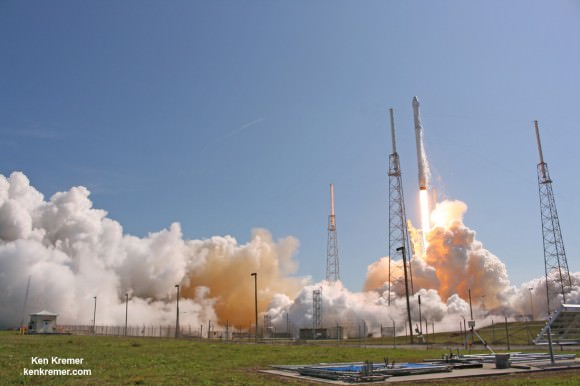
The 224 foot tall SpaceX Falcon 9 rocket is scheduled to launch at approximately 6:14 p.m. EDT (2214 GMT) on April 27 from Space Launch Complex 40 (SLC-40) at Cape Canaveral Air Force Station, Florida. It will deliver the TurkmenÄlem52E/MonacoSat satellite to a geosynchronous transfer orbit.
This first satellite ever for Turkmenistan will be deployed approximately 32 minutes after liftoff of the fifth Falcon 9 rocket this year.
The outlook is currently 60 percent GO for favorable weather conditions at launch time.
You can watch the launch live via a SpaceX webcast that begins about 20 minutes before launch at: spacex.com/webcast
The May 5 pad abort test for NASA is critical for the timely development of the human rated Dragon that NASA is counting on to restore the US capability to launch astronauts from US soil to the space station.
The test will simulate an emergency abort from a test stand and will also take place from the Cape’s Space Launch Complex 40 in Florida.
SpaceX has a four hour launch window in which to conduct the test. The test window opens at 9:30 a.m. EDT (1330 GMT) on May 5. There is a backup opportunity on May 6.
The pad abort demonstration will test the ability of a set of eight SuperDraco engines built into the side walls of the crew Dragon to pull the vehicle away from the launch pad in a split second in a simulated emergency.
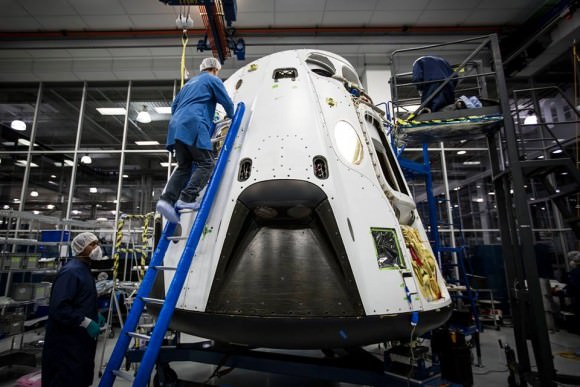
The purpose is to test the ability of the abort system to save astronauts lives in the event of a real emergency.
The SuperDraco engines are located in four jet packs around the base. Each enigne can produce up to 120,000 pounds of axial thrust to carry astronauts to safety, according to a SpaceX description.
Here is a SpaceX video of SuperDraco’s being hot fire tested in Texas.
Video caption: Full functionality of Crew Dragon’s SuperDraco jetpacks demonstrated with hotfire test in McGregor, TX. Credit: SpaceX
The pad abort test is being done under SpaceX’s Commercial Crew Integrated Capability (CCiCap) agreement with NASA.
The initial pad abort test will test the ability of the full-size Dragon to safely push away and escape in case of a failure of its Falcon 9 booster rocket in the moments around launch, right at the launch pad.
“The purpose of the pad abort test is to demonstrate Dragon has enough total impulse (thrust) to safely abort,” SpaceX spokeswoman Emily Shanklin informed me.
For that test, Dragon will use its pusher escape abort thrusters to lift the Dragon safely away from the failing rocket.
The vehicle will be positioned on a structural facsimile of the Dragon trunk in which the actual Falcon 9/Dragon interfaces will be represented by mockups. The test will not include an actual Falcon 9 booster.
A second Dragon flight test follow later in the year. It involves simulating an in flight emergency abort scenario during ascent at high altitude at maximum aerodynamic pressure at about T plus 1 minute, to save astronauts lives. The pusher abort thrusters would propel the capsule and crew safely away from a failing Falcon 9 booster for a parachute assisted landing into the Atlantic Ocean.
The SpaceX Dragon V2 and Boeing CST-100 vehicles were selected by NASA last fall for further funding under the auspices of the agency’s Commercial Crew Program (CCP), as the worlds privately developed spaceships to ferry astronauts back and forth to the International Space Station (ISS).
Both SpaceX and Boeing plan to launch the first manned test flights to the ISS with their respective transports in 2017.
During the Sept. 16, 2014 news briefing at the Kennedy Space Center, NASA Administrator Charles Bolden announced that contracts worth a total of $6.8 Billion were awarded to SpaceX to build the manned Dragon V2 and to Boeing to build the manned CST-100.
There will be no attempt to soft land the Falcon 9 first stage during the April 27 launch. The next landing attempt is set for mid-June.
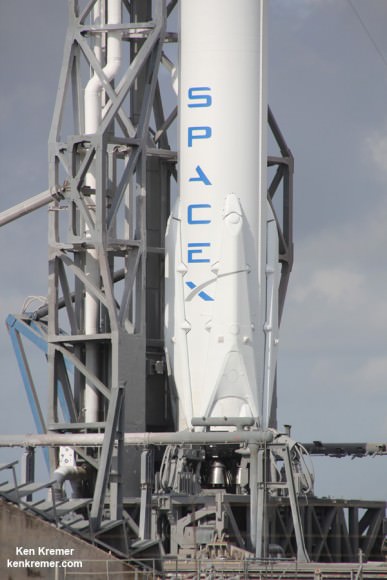
Stay tuned here for Ken’s continuing Earth and planetary science and human spaceflight news.

